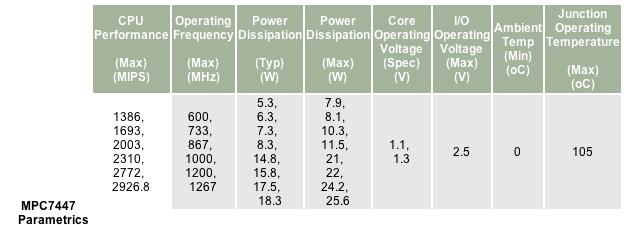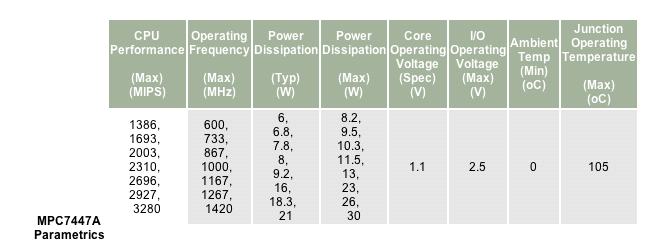PowerBook Processors: The G5 Isn't The Only Future Option
by Charles W. Moore
The G5 PowerBook didn't materialize with the latest round of PowerBook updates, and while some are predicting that we may see one rolled out at the Worldwide Developer's Conference in June, I'm still highly skeptical. Indeed, given the compromises necessary to even get the G5 to work in the G5 iMac, my perspective on the prospects for a G5 PowerBook remains "show me."
However, the G5 is by no means the only option Apple has for boosting laptop performance,
Currently Apple currently buys Freescale G4 MPC7447 and MPC7447A/B CPU chips that are used in the eMac, the Mac mini, iBooks, and Powerbooks.
The 7447x series chips have a 512 kb L2 cache but no L3 cache, and a maximum bus speed of 167 MHz. The 7447 tops out 1.33 GHz, the 7447A at 1.5 GHz, and the 7447B thus far at 1.67 GHz. Whether there is more speed potential in the 7447 chip remains to be seen, but it is partially crippled by its slow bus speed which prevents the full speed of fast DDR memory from being fully utilized with the processor becoming starved for data. Evan with a processor capable of running at higher clock speeds than the current 167 GHz, if it can't get enough data to actually use all that speed, there's little point. The frontside bus still hasn't been upgraded in the latest PowerBooks — it remains 167MHz, running up to ten times slower than the CPU. PowerBook FSB speed has been stuck in the mid-100s since 2001 some point.
Freescale is reportedly sampling a G4 7448 chip with a clock speed of 1.4-2.0 GHz and a bus speed of 200 MHz, along with 1 MB of L2 cache. Since the 7448 is also pin-for-pin and software compatible with the MPC74xx processors — it could easily be plugged into Apple's existing 'Book designs, and is able to consume less than a cool-running 10 Watts at 1.4 GHz. The 7448 should be available sometime in the next few months. The 7448 may well turn out to be be the last iteration of the G4 744x series chips.
More exciting is the Freescale e600, projected for production sometime in the first half of 2006, which will be available in pin compatible single and dual core versions, and looking farther into the future, the e700, a 32/64 bit chip supporting clock speeds beyond 3 GHz.
There are good reasons why the coming new G4 chips from Freescale may make more sense as PowerBook and iBook CPUs than the IBM G5 chips, those reasons being the G5's prodigious heat-producing and power sucking characteristics.
The Freescale 7447, a high-performance, low-power 32-bit implementation of the PowerPC RISC architecture with a full 128-bit implementation of Freescale's AltiVec technology, and manufactured on Freescale's 0.13-micron HiPerMOS silicon-on-insulator (SOI) copper interconnect process technology, when used in various PowerBook and iBook applications at 1GHz typically uses less than 10W.

For some frame of reference, a PowerPC 7455 (G4) uses approximately 20 watts at 1.42 GHz. while the PowerPC 750FX (G3)uses about 3.6 watts at 1.0 GHz. ( http://ffden-2.phys.uaf.edu/212_fall2003.web.dir/David_Giessel/trans.html )
Designed as pin-compatible replacements for Freescale's MPC7447 products, the 7447A can reach clock speeds of 1.5 GHz, and benefits from Freescale's silicon-on-insulator (SOI) process technology, engineered to help deliver significant power savings without sacrificing speed. Low-power versions of the MPC7447A are available. Temperature sensing diodes included to monitor die temperature. At 1.42 GHz the 7447A typically uses about 19 watts.

Reader Peter da Silva recently supplied me with an interesting workup comparing specs. and characteristics of G4 and G5 chips.
G5: 1.6 GHz, 800 MHz FSB, single core, 20-stage pipeline, 50+ watts.
G4 (MPC74xx): 1.5 GHz, 166 MHz FSB, single core, 7-stage pipeline, 10-50 watts.
G4 (MPC8641D): 1.5 GHz, 768 MHz FSB, dual-core, 7-stage pipeline, 15+ watts.
"Once you get past that 166 MHz bus on the old G4, who the heck wants a G5?" Peter asks. Good question. Remember that thus far the G5 requires at least three cooling fans (iMac) and as many as seven (Power Mac) in Apple desktop configurations. There is anecdotal indication that the three fans in the iMac may not be enough, with reports of more than expected power supply failures, and even of the case distorting from excessive heat. Making these furnaces work satisfactorily in a PowerBook form factor really will be "the mother of all thermal engineering challenges."
Now, that said, last month engadget's Joshua Fruhlinger reported that while "the current G5 chip, the IBM 970FX, is just too hot and power-hungry to make it a viable portable CPU.... a new chip-making process using something called strained silicon promises to produce a less-power-hungry G5 chip that will make a PowerBook G5 a reality." Strained silicon is a manufacturing technique that boosts performance by speeding up the transistors, the tiny on-off switches inside the chips. That can lead to better chip performance and lower power consumption. I hope this will work, but I remain skeptical that the G5, which was originally designed for use in mainframes, represents as desirable a CPU for portables as the upcoming Freescale e600 and e700 G4s. When I say "work," I don't mean a lot of howling fans going all the time. 15 watts and up sounds a lot more doable than 50 watts and up, and with very little sacrifice in bus speed.
As CNET News.com's John G. Spooner and David Becker noted in a February 1 commentary, "a G5 PowerBook would require compromises in size, weight and other aesthetics such as noise production. Apple, and likely most of its customers, wouldn't be willing to live with that..... to fit the G5 into a typical PowerBook-size chassis, Apple would have to throttle down the G5, causing the chip to run more slowly than current G4 mobile chips." Be careful what you wish for.
"It is fair to say that incorporating a G5 into a notebook as thin and light as the PowerBook is extremely difficult," David Moody, vice president of worldwide Mac product marketing at Apple, told CNET News.com on January 31.
What about the much ballyhooed IBM/Sony/Toshiba PowerPC-based Cell Processor? Well, while i sounds very impressive on paper, especially with its scalability and integrated support for virtualization and speedy video performance, analysts note that differences between the Cell and the current PowerPC architectures would make any transition an unlikely prospect for the next few years.
More likely is Freescale's e600 MPC8641D Dual Core Processor mentioned above, which integrates two e600 PowerPC cores, two memory controllers, Ethernet controllers, a RapidIO fabric interface, a PCI Express I/O interface, and a high performance MPX bus that scales to 667 MHz. However, the real frosting on the cake is that it draws as little as 15 W — roughly the same ballpark (or less) as the current G4 chips Apple's using. Typical use, depending on clock speed, is 15-25 watts
Also coming is the Freescale e600 MPC8641 Processor, a single core version of the dual core processor with the same level of peripheral integration - but at a lower power point,and which is pin-for-pin compatible with the dual core processor, and will use 10-15 watts.
The e600 core is is designed to issue four instructions per clock cycle (three instructions plus one branch) into eleven independent execution units, and to include a full 128-bit implementation of Freescale's advanced AltiVec Single Instruction Multiple Data (SIMD) vector processing technology.
Pretty cool, eh? Production is tentatively projected for the first half of 2006.
All of these new Freescale chips utilize 90nm silicon-on-insulator (SOI) technology, and are 32 bit, but I am of a mind that 64 bit support will continue to be largely irrelevant to laptop users for the foreseeable future.
Looking farther into the G4 future, Freescale's forthcoming e700 chips are planned to be capable of running both 32-bit and 64-bit software and scaling to 3 GHz and beyond in next-generation process technologies.
For more information, visit here.
The PowerBook Zone also ran an interesting series of reader-submitted pieces on the topic of future PowerBook chips in February, which can be found here:
http://www.pbzone.com/archive/0205.shtml
So, once again, be careful what your wish for. A G5 PowerBook might be less desirable in practical terms than one powered by a G4 for some time yet.